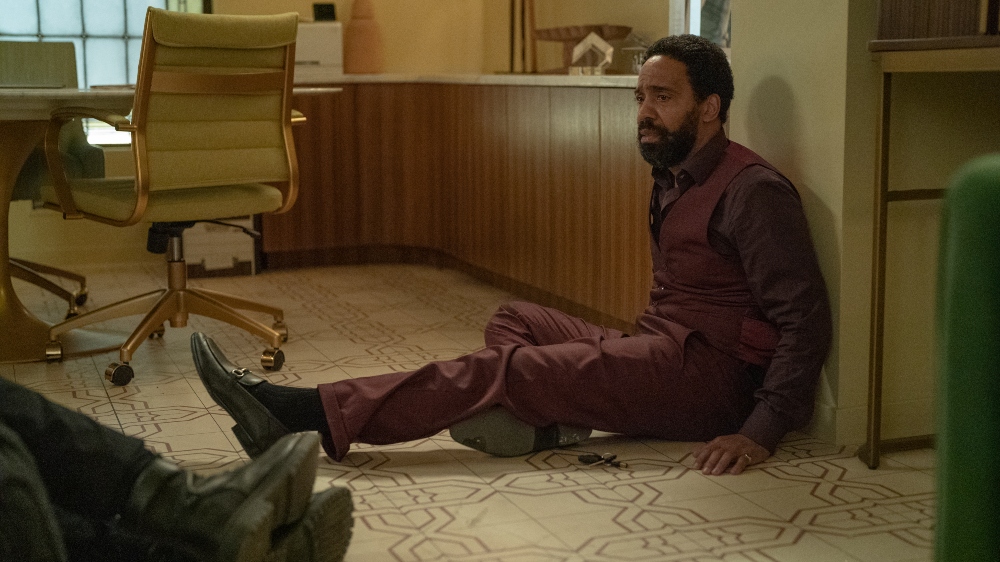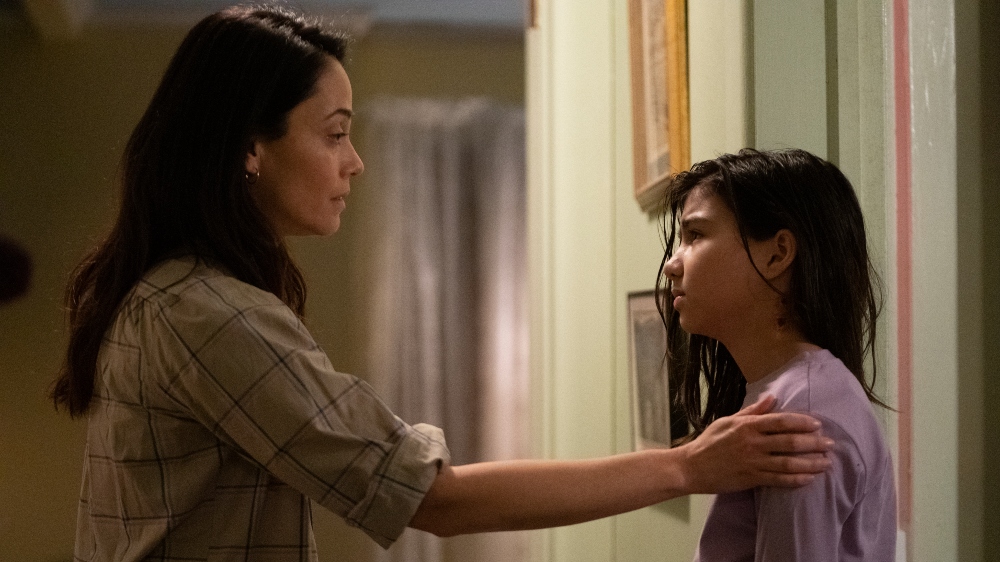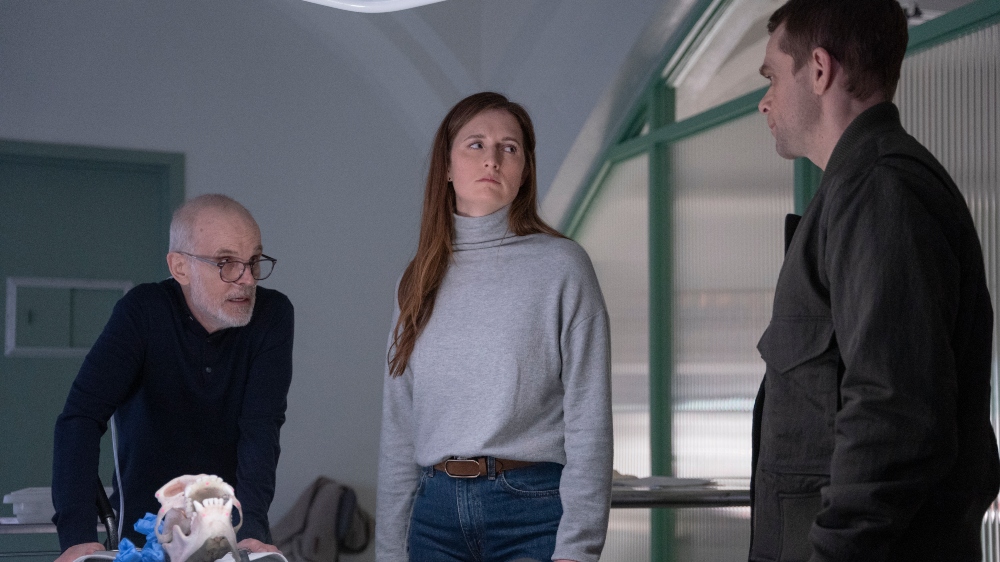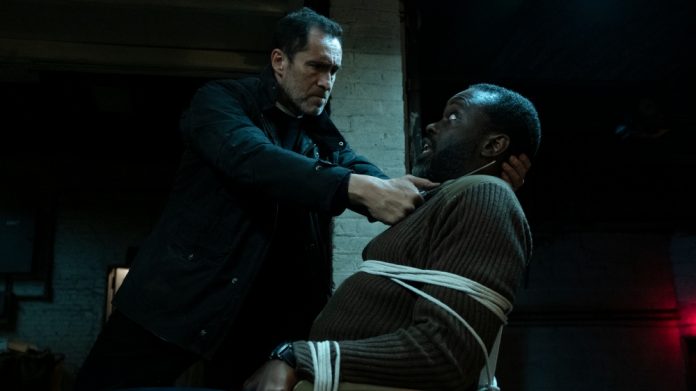When you think of vampire stories, “humanity” and “empathy” aren’t the first words typically associated with the genre, but for Let the Right One In Director/EP Seith Mann, (The Breaks, #Freerayshawn), it was those very ideas that drew him to the Showtime series, which offered him the chance to explore them further.
Mann said he was also taken in by the “wonderful writing” from award-winning playwright Andrew Hinderaker, and excited by the opportunity to work with Oscar-nominated actor Demián Bichir. But in addition to all of that, it was Mann’s personal connection to the material as a father of two that made him sign on to this story of a father, Mark Kane (Bichir), who would do anything to protect his child.
Let the Right One In is based on the 2004 novel by John Ajvide Lindqvist, who then adapted it in 2008 as a Swedish film, which earned critical acclaim and spawned an English-language remake (Let Me In) from director Matt Reeves that starred Kodi Smit-McPhee and Chloë Grace Moretz. The Showtime series, however, is its own separate thing, and it stars Madison Taylor Baez as Eleanor Kane, Mark’s 12-year-old daughter who must navigate the world as a vampire despite yearning for human connection in the form of her best friend, Isaiah (Ian Foreman). Therein lies the humanity that Mann was drawn to, along with the unique parent-child relationships between Mark and Eleanor, and Isaiah and his single mother, Naomi (Anika Noni Rose), who also happens to be a homicide detective.
Mann’s journey as a filmmaker began as an undergrad at Morehouse College in Atlanta. Inspired to become a director after seeing Do the Right Thing, he ironically came to the attention of fellow alumnus Spike Lee with his New York University thesis film, a short titled Five Deep Breaths. Mann was awarded the Spike Lee Fellowship while in production in 2002, earning him film festival recognition the following year. To date, he has directed over 50 episodes of television, with credits including The Wire, The Walking Dead, and Homeland.
Above the Line recently spoke with Seith Mann via Zoom from South Africa, where he’s been busy directing and executive producing King Shaka, which will be his next project for Showtime. Mann talked about what sets Let the Right One In apart from other vampire shows and explained why it’s important to give young actors a safe place to play when directing them. The series debuted Oct. 9 and its finale airs this coming Sunday, so read below to find out Mann’s favorite scenes in the episodes he directed (“Anything For Blood,” “Intercessors,” and “Broken Glass”), as well as the secrets behind Baez’s wall-climbing prowess and blood-draining stunts.

Above the Line: Vampire shows seems to be very popular right now. What makes Let the Right One In special?
Seith Mann: At the end of the day, it really is about humanity, and [that’s] one of the things that first attracted me to the project. When I first read Andrew [Hinderaker‘s] script, I read it a little suspiciously, honestly, because I’d seen the movie, I loved the movie, and was aware of an adaptation. So I really attacked it with a sort of “let me read it. I’m curious, but I know they’re gonna screw this up” [attitude]. And then, to my pleasant surprise, not only did they not screw it up, but it really connected to me on an emotional level as a parent and being able to relate to, in particular, what Mark was going through as the father of a child that was dealing with this condition.
And then, seeing Naomi’s relationship with her child presented more normal sort of mundane challenges of a modern parent dealing with their kid who is maybe a little awkward socially. Then, when you looked at what Arthur (Zeljko Ivanek) was doing and what Grace (Gummer as Claire Logan) was doing and the (brother) Peter storyline; all these people from Mark, Grace, and Arthur, who ultimately were behaving very badly. In the space of the pilot (“Anything For Blood”) Mark does something that is reprehensible but at the same time, you understand the motivation for it, you understand the humanity behind it, and you not only forgive him, [but] you can actually relate. “Well, if I was in that situation, would I do the same thing?” And the answer is, I probably would.
ATL: How did you personally connect to the story as a father?
Mann: I have two sons. It impacted me in the sense that when you’re trying to find your connection to the character, and [you discover] what that character is going through. This was very easy for me to understand — the pressure on him. All you want for your children, ultimately, is for them to live, thrive, be happy and healthy, and to find what their calling is, what it is that they are good at, what it is that they want to do, and help them succeed in doing that thing. And he’s broken it down to, like, ‘I’m just trying to keep my daughter alive so that I can find a way to get her back to a normal existence. I wanna return to her the childhood she lost. I don’t want her to be a monster.”
He is a man with a certain kind of morality, what I would call “innate goodness.” I think in the balance of things, he’s a man that’s more good than bad, and yet to keep his daughter alive, which is a very basic responsibility of any parent, he’s suddenly in a position where he has to [commit] murder, and he’s not only [killing] because of the reality of how she needs to eat, but he’s also trying to absorb that cross for her so [that] she doesn’t have to do it. To have that conflict of a fundamentally good man trying to do the right thing and having to do all these wrong things to do right by his daughter… it had heart. It was a tremendous story. It’s one I understand and [could] relate to and connect with.
ATL: I think Demián Bichir deserves an Emmy for his performance. How did you direct him to those places of empathy when his character is so reprehensible in his actions?
Mann: Demián is a tremendous actor. It was really just one of those easy collaborations, if I’m honest. Andrew, myself, and Demián talked early on about the character, about the story, and then we would just come to set and play. He came with a very thorough understanding of Mark, of all the issues and things that I’m talking about, and just brought a real humanity to the role. I don’t think Demián is capable of acting badly. I mean that as a thespian. He’s human, too, so I’m sure he can act badly from time to time, but even when he’s bad, he’s good. Even when he plays the bad guy, he’s so good. And we may think, ‘hmm, if I was in the same situation… God, thank you, I’m not, [but] I might make the same choices.’ That doesn’t mean that those choices, whether we can forgive him, whether we can empathize with him or not, [it] doesn’t mean there aren’t consequences that affect other people whose humanity we can connect to or are connected to. It’s tragic all the way around. It’s complicated, it’s fucked up, and it’s beautiful — like life.

ATL: Let’s talk about some of the cool stunts. Can you reveal how Eleanor (Madison Taylor Baez) scales the wall?
Mann: When she climbs the wall in the first episode, that was a combination of a Digi double, and we built some of the wall on the stage and then laid it down so it wasn’t actually a vertical angle. [It wasn’t] completely flat, but a very shallow pitch. She climbed a piece of that for certain shots, and then certain shots was a Digi double.
ATL: Was she also on a wire?
Mann: On that, she was in a harness in a rig that she was attached to, but with the Digi double, we just put the camera where we needed [it] to be, talked with the visual effects artists, and did the frame that we wanted, and [then] they did the rest.
ATL: Did you offer Madison any special direction when it came to the art of the vampire bite?
Mann: My approach is, I’m a big believer in “play” and that works well with child actors — and adult actors, frankly. We would just play until it felt right. Vampire folklore is not unheard of or unseen in pop culture so I’m sure she’d seen some things, and then we would audition some things on set. When we found the vocabulary and the movement and the nuance that felt right for her character, that’s where we went.
ATL: I can imagine there were very funny moments between takes. What was the atmosphere like on the set?
Mann: There was not a lot of drama. The cast was just lovely. The kids were great… and kids ain’t always great. These kids were a dream. Ian [Foreman] and Madison were a delight. They were always prepared [and] very mature for their age. Ian’s mom lives in Atlanta, where I live, and my oldest is just a little bit younger than Ian. I kept trying to get her to just take my boy for a couple of weeks, and sprinkle some of that good parenting dust that [she was sprinkling] on Ian, because the kid is amazing. To be professional on a set is something that some grown folks can’t do consistently [laughs], but both of these kids came to play at work and were very competent professionals. They played in front of the lens when they needed to for their character work and for their performance, and when it wasn’t rolling, they were like professionals. It was beautiful and amazing to see. I know I was not, when I was that age, capable of that kind of attention span, focus, discipline… all that it takes.

ATL: What was the connection between Demián and Madison like when they weren’t shooting, because their chemistry as father and daughter is so wonderful on the show?
Mann: I don’t know that there was a lot of horseplay, but the atmosphere was very laid back and easy. I think Demián, as much as anyone else, as much as myself, as much as Andrew, as much as our AD team and our fantastic DP, Eric Bronco, I think he helped create an environment for the kids, [and] Madison, in particular, ’cause most of his work was with Madison early on, [so] she just felt safe and comfortable and easy.
On a film set and a pilot, there’s inherent stress involved, but I would be surprised if the children felt a lot of it. Demián was a great part of just helping [to] create that atmosphere. The same with Anika [Noni Rose] with Ian. It was easy and it was relaxed, and I think that the quality of the performances that the [kids] gave grows out of that ease, that comfort, that safety. I think that’s one of the most critical things in terms of getting the quality of performance that we got from them.
ATL: What about your job is the most fun for you?
Mann: I love post, I love production, and I love when you find that kind of look. You plan when you can, you make plans for these scenes and you do them. The way I work, I may plan a thing, and then when I get with the cast, it’s sort of like an idea. It’s not very rigid. It’s not fixed. It’s sort of like, ‘this is what I think might happen, let’s try it out,’ and if it works, it’s like, ‘Hey, you know, I was 90 percent right this time.’ Sometimes I’m 10 percent right but it’s still cool as long as the work is honest. I do enjoy it when my theory is pretty close to correct, but I also enjoy discovering that unexpected thing. As much as you’ve read a scene [and] talked about a scene, seeing those emotions come to life [is different and exciting].
ATL: Do you have an example of a scene in which you were 90 percent right?
Mann: One was when Mark and Zeke (Kevin Carroll) talk at the bar. It was just two old friends, two best friends who have been estranged because of these crazy circumstances. They’re having their first real conversation in years and it’s written beautifully. Actually, it’s super simply staged — just two guys at a bar talking. There’s no fancy camera work or anything like that, but seeing these men connect and feeling that history and knowing they just met fairly recently again… seeing two real masters at their craft play and create real human connection and tension and feeling the love that’s underneath their relationship despite the distance, despite the years apart… seeing it come alive [and] seeing that lived history is fun for me.
When Eleanor and Mark have their argument on the street [and] just become very raw with each other, Madison — I should say in this context — really just kind of breaks out as a performer in that moment, [and you] really [saw] the depth of emotion that she could access, which is not a given. She was 12 when she [did] that scene, maybe 13.

ATL: Which scene really hit home for you personally?
Mann: There’s the scene between Naomi and Frank (Ato Essandoh) and Isaiah at the dinner table, and you get, in a snapshot, that this is a family that has gone through a divorce and is estranged and is trying to function, co-parenting, getting a glimpse of what they could have looked like if they worked. I forget how old I was when my father and my mother got divorced when I was very young, [but] there was an occasion when we were all together, which was a rare thing, and someone took a picture of us and I was very curious to see what that picture looked like because I’d never known us as a family. The picture never came out, so I still don’t know.
ATL: There are several scenes where you have actors, without giving too much away, hanging upside down, and being drained of blood. Were they given a safe word?
Mann: I can’t remember if we actually had a safe word per se, but we pay a lot of attention to safety. I’m glad you asked that question because it’s important industry-wide that we pay attention to it. I, myself, in particular, I’m always very, very conscientious. I try to create an environment where safety is our number one priority. We wanna make a good show, blah, blah, blah, but [the] most important [thing] is that people are safe, get home safely, and feel safe. So whenever we had to hang an actor, [the] stunt [department] is involved, [the] special effects [team] is involved, everybody’s involved to make sure that they’re comfortable so that we don’t have them upside down [for] too long.
Not to say that the stunt player’s safety is any more or less important than a non-stunt player, but where we can use the stunt player who has been trained and has a certain, understanding of their physicality, we’ll use that person as much as possible rather than the actor who may not have that background, or a dummy, if that is helpful in getting the shot. We just always make sure that actors know they can communicate, they can cut if something feels wrong or off. The safe word is “cut.”
ATL: What do you hope audiences come away with when they finish watching the show? I have a feeling there are more seasons coming, no?
Mann: I have that same feeling. I think you want the audience to be engaged and entertained and you want to pull their heartstrings [and] terrorize them at times. You want all of those things. But ultimately, for me as a director, particularly when it’s something I didn’t write [and] I first read something, I try to remember what I felt and why I’m interested in doing the thing. I take it as my responsibility to try to amplify that and give the larger audience the same experience that I had. And when I first read the script, I felt a lot more empathetic and forgiving of humanity. There are so many things that we do. It gave me space to say, sometimes, when a person has done [a] terrible thing, it might be for reasons that you would ultimately not have much empathy for, but you know, sometimes people are doing these terrible things out of love, and that, in a way, makes me more tolerant and forgiving of my fellow humans.
The season finale of Let the Right One In will air this coming Sunday night on Showtime.



